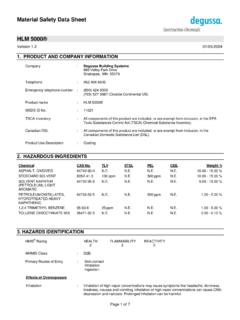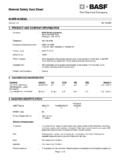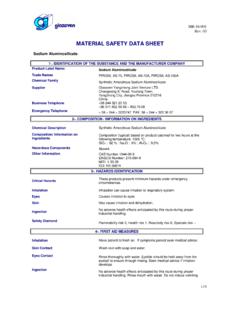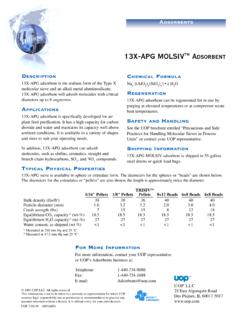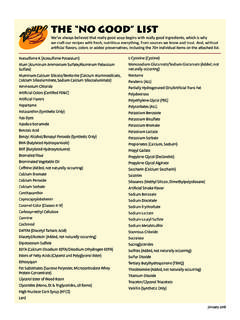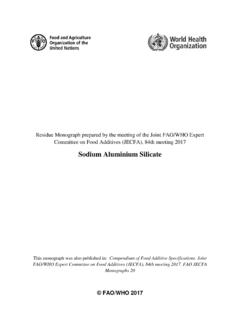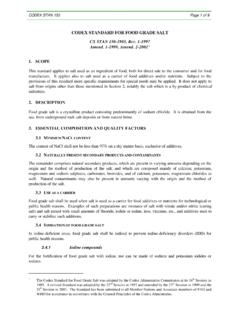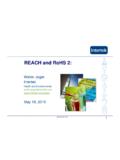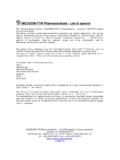Transcription of Material Safety Data Sheet - csiconcrete.com
1 FLY ASHM aterial Safety data Sheet Hazardous Nature: This product is potentially classified as hazardous depending on jurisdiction and Identification: Pozzolan, Fly Ash, Class F Fly Ash, Class C Fly AshUse: Supplementary cementitious Material for concrete and concrete products. Also used in soil stabilization and as a fine fillerin asphalt and other products. Hazardous Chem Code: Not Applicable Poisons Schedule: Not Scheduled Dangerous Goods Class: Not Applicable Physical Description/Properties: Appearance: Fine powder - light to dark grey or shades of brown or buff in color. Boiling/Melting Point: Melting point > 1400 o C Vapour Pressure: Not Applicable Percent Volatiles: Not Applicable Specific Gravity: to Flash Point: Not Applicable Flammability Limits: Not Applicable Auto Ignition Temp: Not Applicable Solubility In Water: Essentially insoluble.
2 Some Class C fly ashes may have soluble sodium sulfate (1-8%). Respirable Fraction: Approximately 20% - 40% of particles are below 7 micron in diameter ( in the respirable range). Other Properties: Not ApplicableIngredients: Chemical Entity Proportions Silica-Crystalline, as Quartz 1-5% Mullite 1 - 5%Note: Fly ash is a byproduct of coal combustion. The Material is composed primarily of complex aluminosilicate glass, mullite,hematite, magnetite spinel and quartz. The proportion of quartz (crystalline silica) in the fly ash varies depending on the quartzcontent of the coal. Class C fly ash may have 1-7% free CaO and calcium sulfate as well as calcium aluminosilicate Hazard Information: Short Term Exposure Swallowed: Unlikely under normal conditions of use.
3 Swallowing fly ash may cause abdominal discomfort. Eyes: Irritating to eyes causing watering and redness. Skin: Irritating to skin - can cause irritant/contact dermatitis from mechanical abrasion or alkaline composition(Class C flyash). Inhaled: Irritating to the nose, throat and respiratory tract causing coughing and sneezing. Long Term Exposure Swallowed: Not Applicable Eyes: Not Applicable Skin: Not Applicable Inhaled: Repeated inhalation of dust containing crystalline silica can cause bronchitis, silicosis (scarring of the lung) and lungcancer. It may also increase the risk of scleroderma (a disease affecting the connective tissue of the skin, joints, bloodvessels and internal organs).
4 Studies have shown that smoking increases the risk of bronchitis, silicosis and lung cancer inpersons exposed to crystalline silica. It is recommended that all storage and work areas should be smoke free of high levels of fly ash dust may result in severe inflammation of the small airways of the lung and Aid: Swallowed: Give plenty of water to drink. If any acute gastrointestinal distress, seek medical attention. Eyes: Flush thoroughly with flowing water for 15 minutes. If symptoms or irritation persist, seek medical attention. Skin: Wash thoroughly with mild soap and water. Some Class C fly ashes are quite hydraulic and alkaline; contact with wetskin may result in burns.
5 Inhaled: Remove to fresh air, away from dusty area. If symptoms persist, seek medical Limits Crystalline Silica (Quartz): mg/m 3 TWA (time-weighted average) as respirable dust. Dust (NOS - not otherwise specified): 10 mg/m 3 TWA as inspirable dust. However, where a state, territory or local authorityprescribes a lower exposure standard, the lower standard applies. Recommendations: Keep exposure to dust as low as practicable. Respirable crystalline silica levels should be kept mg/m 3 TWA, and respirable dust below 5 mg/m 3 Controls: Avoid generating dust. When handling fly ash, use local mechanical ventilation or extraction in areaswhere dust could escape into the work environment.
6 For bulk deliveries, closed pumping systems are recommended. Forhandling of individual bags, follow instructions below if no local exhaust ventilation is available. Work areas should be cleanedregularly by wet sweeping or vacuuming. If generating dust cannot be avoided, follow personal protection Protection: Skin: Wear loose comfortable clothing. Wash work clothes regularly. Apply barrier cream to hands or wear cotton or light dutyleather gloves or equivalent. Eyes: Safety spectacles with side shields or Safety goggles should be worn if dust likely to be generated. Respiratory: None required if engineering and handling controls are adequate.
7 If dust is generated wear a suitable particulaterespirator . Use only respirators which bear the standards mark and are fitted correctly. Note that persons with facial hair willhave difficulty in obtaining a satisfactory face seal. Ventilation: Refer to Engineering ControlsFlammability: Non-flammableStorage and Transport: Keep in a dry place. When handled pneumatically use standard dust filters on vehicles and and Disposal: Follow above Safety requirements under "Precautions for Use" and wet sweep or vacuum dust withindustrial vacuum cleaner. A fine water spray should be used to suppress dust when sweeping. Collect in containers anddispose of as trade waste in accordance with local authority guidelines.
8 Keep out of stormwater and sewer drains. Fire/Explosion Hazard: Not flammable. Does not decompose on heating. Note: The provision of this information should not be construed as a recommendation to use this product in violation of anypatent rights or in breach of any statute or regulation. Users are advised to make their own determination as to the suitabilityof this information in relation to their particular purposes and specific circumstances. Each user should read this MSDS andconsider the information in the context of how the product will be handled and used in the workplace and in conjunction withother substances or products.
9 Individual responsibility must be taken as to proper use and handling of product.
![Material Safety Data Sheet [OSHA 29 CFR 1910.1200]](/cache/preview/4/c/b/c/4/a/8/a/thumb-4cbc4a8a9c5d11b0cd83f70485b4b281.jpg)
